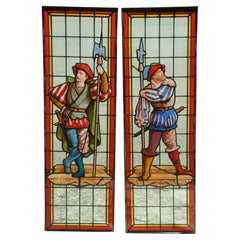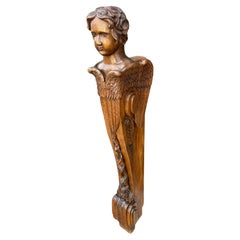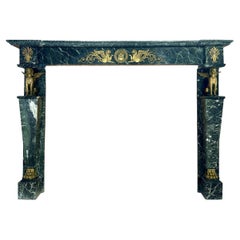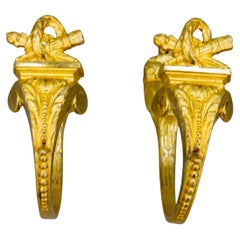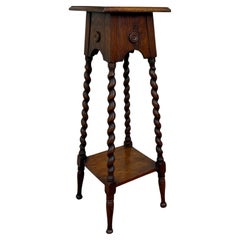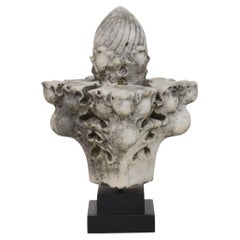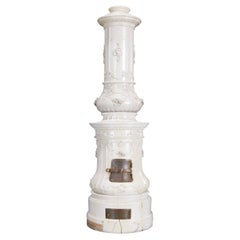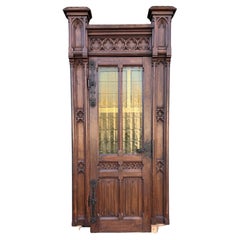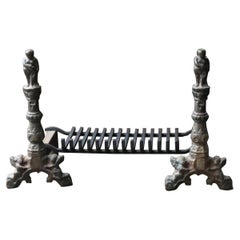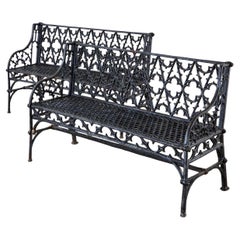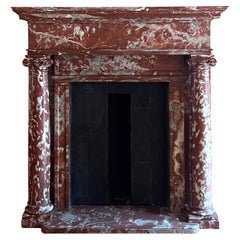Revival Building and Garden Elements
to
55
235
231
467
18
3
Height
to
Width
to
2,909
2,213
1,593
1,375
972
822
821
810
518
496
465
314
297
243
208
156
143
122
13
285
169
21
68
39
26
13
1
12
5
2
7
5
10
3
250
140
136
109
95
371
122
100
85
77
488
475
476
4
3
2
2
2
Style: Revival
French 19th Century Neo Gothic Marble finial
Located in Buisson, FR
Wonderful small architectural fragment.
White marble finial in Gothic style.
France circa 1850. weathered.
Measurements include the wooden base.
Category
19th Century French Antique Revival Building and Garden Elements
Materials
Marble
$472 Sale Price
31% Off
19th-Century Continental Neoclassic Faience Stove from the Iris Apfel Collection
Located in Morristown, NJ
France or Italy, 19th Century, tin-glazed terracotta, in three stacked sections with domed wooden cap, featuring raised foliate scrollwork, floral garlands, and Rococo-inspired carto...
Category
19th Century Italian Antique Revival Building and Garden Elements
Materials
Brass
Impressive Antique Hand Carved Oak Gothic Revival Door Complete with Wall Frame
Located in Lisse, NL
Stunning Gothic architectural door with strong iron hardware in original frame.
This striking and all hand carved door was originally probably part of a church or monastery and the ...
Category
19th Century European Antique Revival Building and Garden Elements
Materials
Iron
French Neogothic Fire Grate, Fireplace Grate
Located in Amerongen, Amerongen
20th century French Neo-gothic fireplace basket - fire basket made of wrought iron and cast iron. The basket is in a good condition and is fully functional. The total width of the fr...
Category
20th Century French Revival Building and Garden Elements
Materials
Iron, Wrought Iron
Pair English Coalbrookdale Style Iron Gothic Garden Benches
Located in Rio Vista, CA
English Coalbrookdale foundry attributed cast iron garden benches. Made in the Gothic Revival English taste featuring Gothic tracery backrest centered by quatrefoil designs. The grac...
Category
20th Century English Revival Building and Garden Elements
Materials
Iron
Antique Red Languedoc Marble Fireplace Surround For Grand Interior Decor
Located in Beervelde, BE
This Rouge Languedoc marble fireplace embodies the Renaissance Revival style with its intricate detailing and craftsmanship.
The deep red marble, accented with striking white veining...
Category
19th Century Belgian Antique Revival Building and Garden Elements
Materials
Marble
Late 19th Century Wrought Iron & Marble Radiator Cover from a New York Apartment
Located in Philadelphia, PA
This Late 19th Century Wrought Iron and Marble Radiator Cover is a beautiful and functional addition to your classic home. The wrought iron frame adds a touch of elegance while the m...
Category
Late 19th Century North American Antique Revival Building and Garden Elements
Materials
Marble, Iron
Diminutive Antique Wrought Iron Garden Bench
Located in New York, NY
Nice antique garden bench having a wrought iron frame with repeating continuous metal straps which form the seat and back.
This example is in very good, original, clean and ready t...
Category
Early 20th Century Revival Building and Garden Elements
Materials
Wrought Iron
Antique French Fireplace Mantel Surround Renaissance Revival Carved Oak 19thC
Located in Tyler, TX
SUPERB Antique French Fireplace Mantel Surround ~~Renaissance Revival~~HIGHLY CARVED OAK~~c. 1880s
This HANDSOME statement piece will add charm and character to your home or castle~...
Category
Late 19th Century French Antique Revival Building and Garden Elements
Materials
Oak
Pair of Albaster Large Urn Jar Table Lamps, Spain, 1940s
Located in Barcelona, ES
Neoclassical Urn Jar Albaster Table Lamps with Fish Handles, Pair
Two Spanish Neoclassical Albaster Urn Jar Table Lamps, 1930s-1940s
These unique Urn table lamps feature Jar design, ...
Category
20th Century Spanish Revival Building and Garden Elements
Materials
Alabaster, Brass
Pair of antique wood carved Gothic Revival architectural Columns
Located in Leesburg, VA
Pair of antique wood carved Gothic Revival architectural Columns
Anonymous
19th century; Belgium or Netherlands
Wood
Approximate size: 41.75 (h) x 11.75 (w) x 11.75 (d) in.
An exceptional pair of tall and intricate hand carved vintage wooden 19th century church columns...
Category
Late 19th Century Belgian Antique Revival Building and Garden Elements
Materials
Wood
Greek Revival Style Bronze Marble Pedestal
Located in Guaynabo, PR
This is a Greek Revival Bronze Marble Pedestal. It depicts a Doric red marble column decorated with a patinated bronze wide band adorned with an egg and dart pattern at the upper par...
Category
20th Century Unknown Revival Building and Garden Elements
Materials
Marble, Bronze
Antique English 4-Post Barley Twist Pedestal Plant Stand Jacobean Oak 39.5" Tall
Located in Tyler, TX
CHARMING Antique English Barley Twist Pedestal or Plant Stand~~39.5" Tall~~c. 1920s-1930s
Beautiful 4-post barley twist pedestal, plant stand, or display table with lower tier~~use ...
Category
1930s French Vintage Revival Building and Garden Elements
Materials
Oak
French Empire Revival Wall Light Sconces in Opaline and Chrome, circa 1970
Located in Trensacq, FR
Beautiful pair of Empire-style sconces, France circa 1970. Stylish, French wall lights in chrome and glossy white opaline glass, a sophisticated modern take on a timeless classic des...
Category
Mid-20th Century French Revival Building and Garden Elements
Materials
Chrome
$653 Sale Price / set
45% Off
Monumental Italian Hand Crafted Wrought Iron Plant Stand and Copper Pot
Located in Milan, IT
Monumental 19th Century Italian Hand Crafted Wrought Iron Plant Stand and Copper Pot
Beautifully Crafted.
Category
Late 19th Century Italian Antique Revival Building and Garden Elements
Materials
Wrought Iron, Copper
Single Alabaster Urn Lamp
Located in Barcelona, ES
Carved Alabaster Table Lamp with Urn Form and Light Inside, Italy, 1930s
Alabaster Urn Lamp.
Outstanding Neoclassical carved alabaster urn lamp with handles.Italy, 1930s Elegant neoc...
Category
Early 20th Century Italian Revival Building and Garden Elements
Materials
Alabaster
$3,156 Sale Price
20% Off
19th Century Portor Marble Fireplace Mantel With Lion Paws - Rare Luxury
Located in Beervelde, BE
This rare 19th century period, antique, French fireplace surround is masterfully carved from Portor marble, one of the world’s most exclusive and dramatic stones, celebrated for its ...
Category
Early 19th Century French Antique Revival Building and Garden Elements
Materials
Marble
French 19th Century Grand Salon Original Marble Fireplace Surround
Located in Beervelde, BE
This Museum quality original antique fireplace mantle in Rouge Griotte marble was installed in Grand interior in Paris. It is a Regency Rococo style from the 19th century. The front ...
Category
19th Century French Antique Revival Building and Garden Elements
Materials
Griotte Marble
Neo-Gothic Flemish hand carved panel in solid oak, ca. 1850
Located in Meulebeke, BE
Belgium / 1850 / panel / oak / Neo-Gothic / Antique
Highly decorative 19th century Flemish panel with hand carved Neo-Gothic decorations in oak. The panel consist of four rectangle ...
Category
19th Century Belgian Antique Revival Building and Garden Elements
Materials
Oak
Monumental Vintage Italian Neoclassical Marble Garden Urn Planter Jardinière 42"
Located in Dayton, OH
An impressive Italian Neoclassical garden Urn. Features a massive stature with a lovely foliate motif. The urn showcases gadrooning at the bottom of the base and fluting over the p...
Category
20th Century Revival Building and Garden Elements
Materials
Marble
$3,150 Sale Price
30% Off
Large Concrete Seated Lion & Cub Statue on Plinth Garden Entry Doorway 50"
Located in Dayton, OH
A large stone lion and cub statue over Grecian plinth base. The lion and cub are facing slightly right with open mouths. A nice detailed example for your garden or entry. Will req...
Category
20th Century Revival Building and Garden Elements
Materials
Concrete
$4,116 Sale Price
30% Off
Monumental Neo-Renaissance Fireplace Mantel, 19th Century, Holland
Located in Haarlem, Noord-Holland
Large Dutch neo-Renaissance antique fireplace, very impressive and grande.
Marble jambs made from beautiful black and green "vert de Patricia".
Oak frieze with paneling and superb ca...
Category
19th Century Dutch Antique Revival Building and Garden Elements
Materials
Marble
Pair of Coalbrookdale Serpent and Grape Pattern Iron Garden Benches
Located in Rio Vista, CA
Spectacular pair of English cast iron garden benches having a "serpent and grape" pattern by Coalbrookdale Foundry. The benches have a rare iron slatted seat and backrest. The end supports feature a snake curled around the legs eating a grape cluster. The gracefully curved arms end with dogs head terminals. The patinated iron has a painted finish. Excellent joinery and craftsmanship from a historic foundry. Also known as "dog and serpent...
Category
19th Century English Antique Revival Building and Garden Elements
Materials
Iron
Antique French PAIR BUFFET WINE Doors Hand Painted Menus Bar Wine Cellar Oak 19C
Located in Tyler, TX
EXQUISTE Antique French PAIR of Oak WINE Buffet Doors~~Early 19th Century
Fabulous pair of painted wine doors can be hung on the wall of any bar or game roo...
Category
Early 19th Century French Antique Revival Building and Garden Elements
Materials
Oak
Neoclassical Alabaster Urn Lamp on Solomonic Pedestal Column
Located in Barcelona, ES
Carved Alabaster Floor Lamp.
Outstanding Neoclassical carved alabaster urn lamp with handles on column pedestal stand, Spain, 1930s-1940s
T...
Category
Early 20th Century Spanish Revival Building and Garden Elements
Materials
Alabaster
Vintage Architectural Hand Painted iron Panel with Gilt
Located in Lomita, CA
Hand-painted iron architectural panel, Indo-Persian/Mughal revival, mid-20th century. Three stacked reserves feature leaping gazelles within scrolling vines and blossoms, rendered in...
Category
Mid-20th Century French Revival Building and Garden Elements
Materials
Iron
19th Century Belgian Antique Fireplace Mantel
Located in Beervelde, BE
This fireplace surround has been built in Belgian Bleu granite with Rouge de Rochefort marble details. The caricatures are very unique with strong impressions. This is one of a kind ...
Category
19th Century Belgian Antique Revival Building and Garden Elements
Materials
Stone
19th Century Italian Hand Carved Giltwood Gothic Style Ornament/ Fragment
Located in Buisson, FR
Beautiful handcarved giltwood gothic style ornament that once adorned a chapel or a church.
Italy, circa 1850. Weathered and small losses. Measurement includes the wooden base.
H:31,...
Category
19th Century Italian Antique Revival Building and Garden Elements
Materials
Wood
$268 Sale Price
52% Off
AWN Pugin Gothic Revival Oak, Leaded & Painted Glass Three-Fold Fire Screen
Located in London, GB
A super quality Gothic Revival oak, leaded and painted high fired glass three-fold fire screen, in the style of AWN Pugin, with roundel and mistletoe decorat...
Category
1860s English Antique Revival Building and Garden Elements
Materials
Stained Glass, Oak
Pair of English Gothic Architectural Giltwood Mirrors ~9 feet tall
Located in Hanover, MA
Truly extraordinary pair of English 19th century Gothic Revival architectural mirrors, nearly 9 feet tall.
In the manner of Augustus Welby Northmore Pugin (aka God's Architect).
I bought these for myself to use in my London flat...
Category
19th Century British Antique Revival Building and Garden Elements
Materials
Gesso, Wood, Mirror
2 Rare Antique 19th C. Neo Renaissance Figural Leaded Stained Glass Windows 52"
Located in Dayton, OH
An impressive Pair of stained glass windows of the highest quality, painted with grisaille and enamels on cathedral glass, circa 19th century. Representing two Renaissance Halberdier...
Category
19th Century Antique Revival Building and Garden Elements
Materials
Stained Glass
$9,100 Sale Price / set
30% Off
1960s Neoclassical Italian Carved Beige Marble Tazza Bowl with Green Pink Veins
Located in New York, NY
Mid-20th Century Italian vintage marble tazza/bowl, entirely handcrafted in Italian Tuscan marble "Fior di pesco". High quality of the hand execution of the turning with double lip, ...
Category
Mid-20th Century Italian Revival Building and Garden Elements
Materials
Marble
Pair of Ormolu Capitals in Neoclassical Style
Located in Madrid, ES
A pair of capitals that were part of some columns, in ormolu bronze, with a neoclassical decoration of Corinthian order.
Category
Late 19th Century French Antique Revival Building and Garden Elements
Materials
Ormolu
$1,016 / set
Monumental Egyptian Revival Bronze Wall Relief Sculpture
Located in Kent, CT
A large and impressive early 20th-century bronze relief sculpture in the Egyptian-Revival style. At the center of the relief is an orb flanked by mirrored cobras and radiating wings ...
Category
1920s Vintage Revival Building and Garden Elements
Materials
Bronze
A large pair of bronze decorative classical urns with Lions heads and cherubs
Located in Dallas, TX
A large impressive pair of Italian bronze outdoor urns . Lions heads on the sides with winged cherubs on top.
Category
Late 19th Century Italian Antique Revival Building and Garden Elements
Materials
Bronze
Pair of English Coalbrookdale Style Gothic Garden Armchairs
Located in Rio Vista, CA
Rare pair of opulent English Gothic revival style garden armchairs made in the manner of Coalbrookdale Foundry. The frames are heavy and solid featuring gothic tracery and quatrefoil...
Category
20th Century English Revival Building and Garden Elements
Materials
Metal
Pair of Mid-19th Century Cast Iron Lyre-Back Garden Chairs
By A. Belokopytoff
Located in Santa Monica, CA
Very heavy American cast iron mid-19th century Rococo and neoclassical garden chairs. Original version Lyre-back splat with cabriole legs and foliate scrolls. Unmarked, but most likely cast by the Robert Wood foundry...
Category
19th Century American Antique Revival Building and Garden Elements
Materials
Iron
Late 19TH Century Cast Iron Lamp Post Base heavy decorative floral relief
Located in Buffalo, NY
Late 19TH Century Cast Iron Lamp Post Base heavy decorative floral relief ..Wonderful design,, 4-sided, (MATCHING) one panel removable (access pane...
Category
1890s American Antique Revival Building and Garden Elements
Materials
Iron
Great Antique Gothic Style Onyx and Bronze Column Pedestal Stand, Marked
Located in Lisse, NL
Wonderful column pedestal with a rotating top for perfectly displaying a work of art or otherwise.
This antique and gothic design pedestal is perfect for showcasing an antique sculp...
Category
Late 19th Century Italian Antique Revival Building and Garden Elements
Materials
Onyx, Bronze
bolection fireplace produced in Italian Breccia Viola marble by Ryan & Smith
Located in Tyrone, Northern Ireland
A stylish and neatly proportioned bolection fireplace produced in Italian Breccia Viola marble
The fireplace has a moulded bolection frame on plain plinths, with a stepped cornice sh...
Category
21st Century and Contemporary Northern Irish Revival Building and Garden Elements
Materials
Breccia Marble
French Egyptian Revival Ebonized Gilt Metal Figural Planter Circa 1950s
Located in Swedesboro, NJ
This French Egyptian Revival ebonized and gilt metal figural planter from the 1950s is a striking example of mid-century neoclassical design inspired by the grandeur of ancient Egypt...
Category
1950s French Vintage Revival Building and Garden Elements
Materials
Metal
A Fine Antique Stone Chimneypiece
Located in London, GB
A fine Antique stone chimneypiece of architectural form, with plinthed tapered column-jambs supporting finely carved lion-fronted scrolled corbels. ...
Category
Mid-19th Century English Antique Revival Building and Garden Elements
Materials
Stone
Heavy Italian Granite Carved Stone Outdoor Picnic Dining Table & Benches 50"
Located in Dayton, OH
Classical Italian Revival Sculpted Granite Picnic Patio Table & Benches. Features acanthus carved edges and scrolled supports. Great for use in the garden or on your porch. Breaks...
Category
20th Century Revival Building and Garden Elements
Materials
Granite
$2,940 Sale Price / set
30% Off
Large Belgian Neo-Gothic Painted and Giltwood Architectural Element
Located in San Francisco, CA
Of Neo-gothic style and large scale with a protruding cornice carved with a meandering foliate vine; above an openwork body with trefoil and quatrefoil pierced reserves over a pointe...
Category
1860s Belgian Antique Revival Building and Garden Elements
Materials
Wood
Gothic Revival Fireplace with its Hood and Carved Salamander, Witch and Ermine
Located in Beuzevillette, FR
Exceptional oak neo-Gothic fireplace and hood. The uprights sides of the fireplace are composed of two columns with capitals foliage patterns, all surmounted by a reserve on which is carved an ermine (heraldic symbol). The lintot of the hearth features a mascaron representing a witch's face carved in high relief with on each side a pattern of parchments. The sculpture on the panelled hood represents a salamander. The salamander is a mythical animal capable of living in fire and extinguishing it. It is a symbol used especially in alchemy and heraldry, it is also the emblem of the King of France François 1er...
Category
Late 19th Century French Antique Revival Building and Garden Elements
Materials
Oak
$21,040 Sale Price
34% Off
Pr. Vintage Henri Studio Classical Style Cement Planters with Cherub Decoration
By Henri Studios
Located in New York, NY
Charming classical revival cement planters attributed to noted maker Henri Studios. The pair feature cupids executed in raised relief, which circle the outside of the planters. Bot...
Category
Late 20th Century American Revival Building and Garden Elements
Materials
Cement
19th Century Black Marble Fireplace, circa 1860
Located in Tyrone, Northern Ireland
19th century black marble fireplace, circa 1860
An exceptional antique highly carved pure black marble fireplace dating to the 1860’s.
The jambs with scrolled acanthus consoles...
Category
19th Century English Antique Revival Building and Garden Elements
Materials
Belgian Black Marble
Egyptian Revivial Gold Giltwood Round Marble Top Figural Pedestal Plant Stand
Located in Philadelphia, PA
Egyptian Revival Style Gold Giltwood Round Marble Top Figural Pedestal Plant Stand. Item features tripod base with winged maiden figures and paw feet, very nice pedestal. Circa Late...
Category
19th Century Antique Revival Building and Garden Elements
Materials
Pottery
Pair of Massive French Wrought Iron Sconces with Frosted Flame Globes
Located in Riverdale, NY
Massive French wrought iron sconces with frosted flame globes suitable for interior or exterior use from the 1930's. From an important, massive estate in...
Category
1930s French Vintage Revival Building and Garden Elements
Materials
Wrought Iron
Gothic Revival Oak Fireplace Mantel with Carved Church Window Panels & Guards
Located in Lisse, NL
Wonderful Gothic Revival fire-place mantle surround with an amazing presence and patina.
If you like Gothic Revival furniture then we are certain you will like this quality made and quality carved, antique Gothic mantle...
Category
Early 20th Century European Revival Building and Garden Elements
Materials
Wood, Oak
19th Century Large French Cast Iron Jardiniere
Located in High Point, NC
Large scale jardiniere, dating to circa 1890-1900. This jardiniere is of decorative cast iron construction. These were historically overpainted, but this one is without paint which...
Category
1880s French Antique Revival Building and Garden Elements
Materials
Iron
Monumental 70" Tall Antique Cast Iron Bronze Garden Urn Planter on Pedestal 1930
Located in Portland, OR
A good monumental antique cast metal garden urn on pedestal circa 1930.
The urn and pedestal are in two sections with a circular urn of monumental size standing on a square plinth, t...
Category
1930s French Vintage Revival Building and Garden Elements
Materials
Metal, Bronze
Cast Aluminum Settees by Molla & Full Embossed Pattern Cushions Pair Available
By Molla
Located in Port Jervis, NY
Fabulous pair ( priced and sold separately) of indoor outdoor patio settees by Molla. Cast Aluminum frames with embossed pattern cushions. Ball and ...
Category
1970s Italian Vintage Revival Building and Garden Elements
Materials
Aluminum
Decorative Pair of Wooden Light Green and Gold Painted Architectural Finials
Located in Leesburg, VA
Decorative Pair of Wooden Light Green and Gold painted Architectural finials
Anonymous
Probably ate 19th or early 20th century; American in the European style
Painted and gilded pine wood
Approximate size: 18 x 6 in.
The present pair of decorative painted wood architectural finials...
Category
20th Century American Revival Building and Garden Elements
Materials
Pine
Pair of Hand-Carved 19th Century Italian Marble Lions
Located in Port Jervis, NY
Hand-carved pair of Carara marble, 19th century, Italy, darkened from age, very heavy weighing about 175lbs each. Some minor chips to marble. In good shape overall. Priced and sold a...
Category
Late 19th Century Italian Antique Revival Building and Garden Elements
Materials
Carrara Marble
Pair of carved Carrara marble sphinxes
Located in SAINT-OUEN-SUR-SEINE, FR
Exceptional pair of white Carrara marble Sphinxes on rectangular bases. A very noble female bust combined with the powerful body of a lioness, recumbent with her tail lying flat on h...
Category
Early 20th Century French Revival Building and Garden Elements
Materials
Carrara Marble
Pair of 19th Century Terra Cotta Winged Lions
Located in Troy, NY
Pair of 19th Century Terra Cotta Winged Lions. Well articulated, impressive pair of terra cotta winged lions, in seated position and holding heraldic shields between their front paws...
Category
19th Century Italian Antique Revival Building and Garden Elements
Materials
Terracotta
$16,500 / set
Rare Hand Carved Stone Wellhead Cistern Basin Antique Fountain Focal Point LA CA
Located in West Hollywood, CA
Rare hand carved stone Wellhead cistern Basin Antique Fountain Focal point LA CA. 19th Century Neogothic Water Wellhead hand carved stone planter Basin ...
Category
19th Century French Antique Revival Building and Garden Elements
Materials
Stone, Limestone, Iron, Wrought Iron
$93,750 Sale Price
25% Off
Antique Gothic Revival Gilt Bronze Dragon Andirons or Firedogs / Fireplace Tools
Located in Lisse, NL
Imagine these in your fireplace with the flames burning on all sides.
These beautifully and all handcrafted, large and fire-gilt bronze andirons are made to stand in your fireplace ...
Category
Late 19th Century French Antique Revival Building and Garden Elements
Materials
Bronze, Wrought Iron, Iron
English Gothic Revival Oak Arched Exterior Door for Glazing
Located in Wormelow, Herefordshire
A substantial unglazed solid English oak arched exterior door in the gothic revival style. This door comes without glass, ready from custom-glazing as you desire, and includes a matc...
Category
Late 19th Century English Antique Revival Building and Garden Elements
Materials
Wood, Oak
Revival building and garden elements for sale on 1stDibs.
Find a broad range of unique Revival building and garden elements for sale on 1stDibs. Many of these items were first offered in the 21st Century and Contemporary, but contemporary artisans have continued to produce works inspired by this style. If you’re looking to add vintage building and garden elements created in this style to your space, the works available on 1stDibs include building and garden elements, decorative objects, tables and other home furnishings, frequently crafted with metal, stone and other materials. If you’re shopping for used Revival building and garden elements made in a specific country, there are Europe, France, and United Kingdom pieces for sale on 1stDibs. While there are many designers and brands associated with original building and garden elements, popular names associated with this style include Maitland Smith, Molla, Henry Hobson Richardson, and Benham & Froud. It’s true that these talented designers have at times inspired knockoffs, but our experienced specialists have partnered with only top vetted sellers to offer authentic pieces that come with a buyer protection guarantee. Prices for building and garden elements differ depending upon multiple factors, including designer, materials, construction methods, condition and provenance. On 1stDibs, the price for these items starts at $119 and tops out at $721,205 while the average work can sell for $3,495.
Still Thinking About These?
All Recently ViewedMore Ways To Browse
Antique Cast Iron Lions Head
Bronze Water Fountains
Brownstone Furniture
Cast Iron Lady
Cast Iron Swan
Cherub Fish
Chinese Rose Garden Seat
Deck Cannon
Fountain Surrounds
Garden Etagere
Greek Oil Jar
Iron Deer
Modern Iron Gate
Spanish Carved Panel
Stone Rams
Victorian French Doors
Vintage Fireplace Poker
Wm H Jackson
